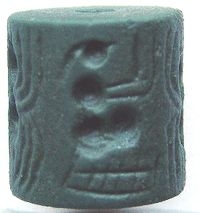In 2008, a soil-survey team was working on a barren dune field in the Western Region of Abu Dhabi, United Arab Emirates. On the surface of the sands, at a place that had been recently disturbed by herders and livestock, the surveyors picked up a two-centimeter, minutely inscribed cylinder. No potshards or any other signs of pre-modern habitation were found. In the journal Arabian Archaeology and Epigraphy, Penn professor Holly Pittman (with archaeologist Daniel Potts from the University of Sydney) describes and discusses the find in an article titled “The Earliest Cylinder Seal in the Arabian Peninsula.”
Pittman is a professor of art history and curator in the Near East Section of the Penn Museum. She has participated in excavations in Cyprus, Turkey, Syria, Iraq and Iran, where she worked for several seasons on digs at Jiroft. Pittman examines ancient artworks and uses them to reconstruct patterns of thought and cultural development as well as historical interactions among the earliest cultures of the Near East. Her books include Art of the Bronze Age: Southeastern Iran, Western Central Asia, and the Indus Valley, Ancient Art in Miniature: Near Eastern Seals from the Collection of Martin and Sarah Cherkasky, The Glazed Steatite Glytic Style: The Structure and Function of an Image System and contributions to the catalog Treasures from the Royal Tombs of Ur.
"My first reaction was that this is the real deal." – Holly Pittman
The tiny artifact stumbled on by the surveying team turned out to be a 5,000 year-old cylinder seal. Pittman says, “My first reaction was that this is the real deal.” These types of seals appeared in the Near East during the Uruk period (4000 – 3100 B.C.) and are strewn in abundance amid ancient ruins and at excavation sites. Cylinder seals are made of a hard material—the Abu Dhabi seal is a greenish-gray stone—and are used to roll an impression on a soft substance like clay. The imprint left by a seal’s engravings on clay over the mouth of a storage jar, for instance, or on a cuneiform tablet signified ownership of the property or the identity of the seal-user.
The engravings on the Abu Dhabi seal, which had been carved with a drill and a graver, depict two females with pigtails and two headless, spider-like images. The iconography and glyphic styles, when compared to previously discovered shards and cylinder seals, suggest the Abu Dhabi seal comes from the Late Uruk, dating from the later fourth millennium B.C. The authors write, “The Abu Dhabi seal … is not merely the earliest cylinder seal yet found in the [United Arab Emirates]. It is the oldest seal of any type ever found in the Arabian Peninsula.”
How the seal came to rest on the dune where the surveyors spotted it is anyone’s guess, they say. It could have been dropped there 5,000 years ago, not long after it was carved, carried by a band of ancient Sumerian merchants who used it to mark their wares and administer their business. Or it may have been worn as “a bead or exotic trinket” in modern times and lost by the herdsmen who trampled up the ground where it was found. “I assume that it got there in the pocket of a traveler coming from the alluvial basin in the north,” Pittman surmises. “I am sure that there are others. After all, we have considerable evidence for pottery and so why not seals and other objects?”



